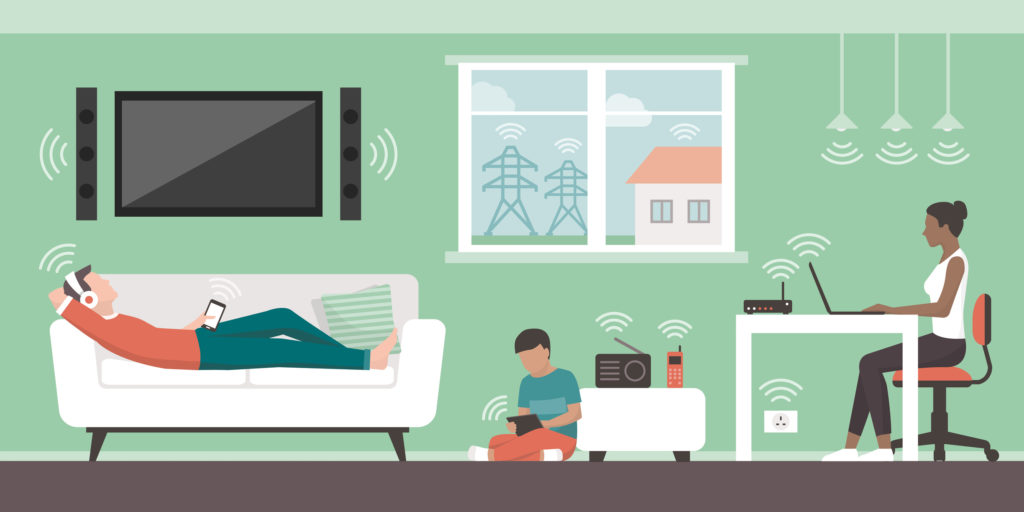From smart phones to solar panels, our lives are infinitely more connected and convenient – thanks to the vast array of gadgets and appliances available at our fingertips. Whilst it’s true that these devices enrich our lives in many ways, mounting evidence warns that our prized possessions could also be double-edged swords providing convenience at the cost of our health.
But why the concern? Beyond the negative impacts on mood and social connection arising from excessive digital technology use, our devices and appliances also emit a low level of radiation, called electromagnetic fields (EMFs). Similar to when a pebble is dropped into still water, EMF’s produce small, radiating waves of energy into their surrounding environment, which have been shown to disturb cellular health.
Similar to when a pebble is dropped into still water, EMF’s produce small, radiating waves of energy into their surrounding environment, which have been shown to disturb cellular health.
So, as our use of technology continues to grow, so too does the concentration of these electromagnetic waves, and the call from health care bodies to establish preventative measures against excessive EMF exposure.

What the EMF?
Preventing excessive exposure to EMFs is important, as in high enough concentrations, exposure can increase the production of reactive oxygen species (ROS). ROS are unstable molecules that cause cellular and DNA damage, which in turn can lead to tissue damage, cellular dysfunction and inflammation. Increased EMF exposure has been linked with the development of tumours, cancer, Alzheimer’s disease and reproductive issues; highlighting how these invisible disturbances can have wide reaching health effects.
This is evidenced by studies that also show 3% of individuals have a severe reaction to EMFs, which manifests symptomatically as sleep disturbances, headaches, fatigue, anxiety and poor concentration that worsen with unmanaged EMF exposure. The same symptoms, with reduced severity, can also be experienced by people exhibiting a mild or moderate reaction to EMFs, however, specific rates of occurrence are yet to be quantified.
It appears that sensitivity to EMFs is influenced by factors such as age, history of exposure, genes that govern detoxification capacity and the stress response, and an individual’s overall health.
Excessive EMF exposure
What then determines if someone will experience EMF-related symptoms? It appears that sensitivity to EMFs is influenced by factors such as age, history of exposure, genes that govern detoxification capacity and the stress response, and an individual’s overall health. In addition, exposure to increasing concentrations of EMFs elevates the risk of symptoms. Examples of situations that result in higher EMF exposure include:
- Talking on a mobile phone for more than 30 minutes per day over the last 5+ years without the use of non-wireless headphones;
- Sleeping near major electrical devices or appliances, including those which share a wall with the bedhead e.g. refrigerator, power box, air-conditioner or Wi-Fi modem;
- Working in an EMF-heavy environment/occupation i.e. office worker, pilot/flight attendant or electrician;
- Exposure to multiple medical imaging devices such as X-rays; and
- Electrocution resulting from occupational exposure or being stuck by lightning.
Based on the above list, what would you estimate your level of EMF exposure to be?

The EMF age
In this modern society, most people are exposed to some level of EMFs, but many don’t link EMFs as a potential cause of their symptoms. Help from a professional who can assess the level of EMFs in your environment, known as a Building Biologist, can provide clarity on your level of exposure. However, beyond this, there are many practical ways you can reduce your EMF exposure, including:
- Choosing hardwired Ethernet cables instead of wireless networks;
- Disconnecting household devices/appliances when not in use;
- Switching devices to ‘flight mode’ overnight;
- Ensuring your bed is not sharing a wall with a power box, modem or other appliances;
- Using a hands free function or wired headphones when speaking on your mobile;
- Storing devices away from you when sleeping, travelling or working to avoid prolonged exposure; and
- Increasing your antioxidant intake to combat any ROS that are produced with exposure i.e. consuming colourful vegetables, herbs and spices such as ginger, turmeric and rosemary, and increasing zinc, selenium, vitamin C and vitamin E rich foods.
Hi-tech health
With the above in mind, it’s worth taking a moment to consider if the EMFs in your environment could be impacting your health. Perhaps trialling a period of EMF minimisation could help determine if you feel better with reduced EMF exposure? However, despite the widespread use of technology, there are still many ways you can proactively balance your technology use with minimising EMF exposure. By modifying and detoxifying your environment, you can balancing the benefits of a hi-tech life with your highest level of health!
Leave a Reply